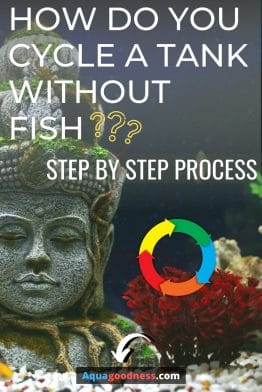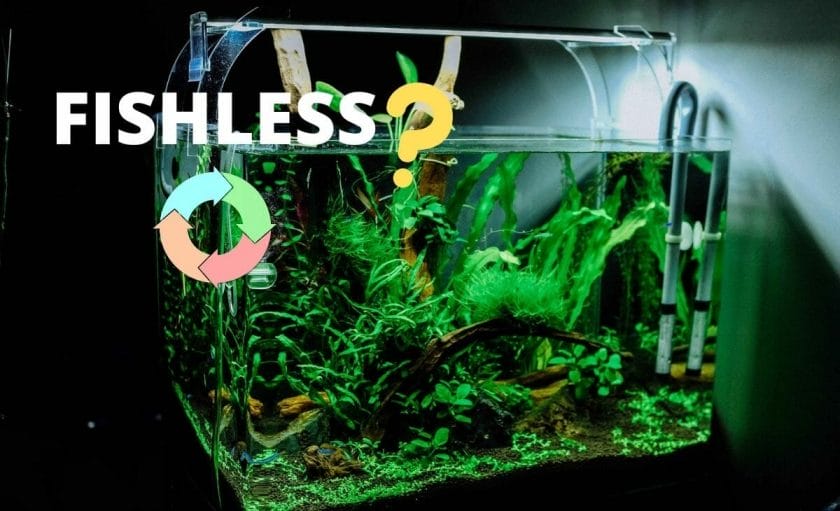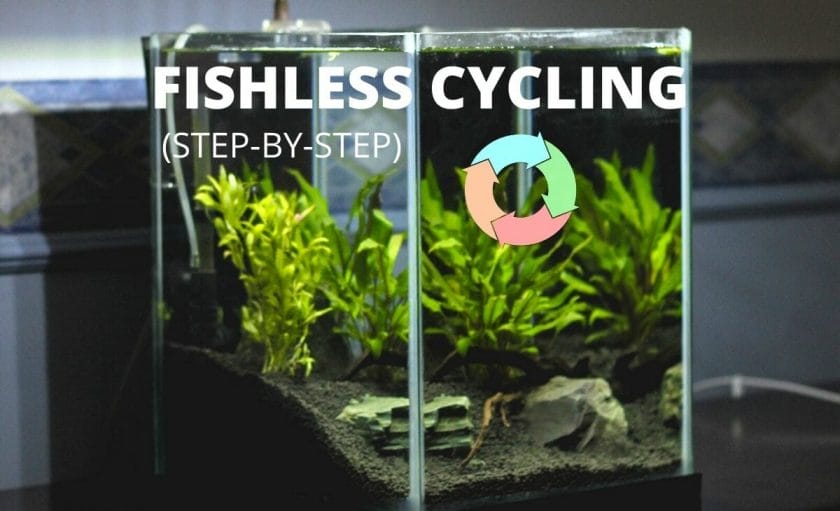Cycling a fish tank without fish is a great way of cycling a fish tank because you’re not risking the life of a fish to cycle the tank.
In this article, I’m going to tell you everything you need to know to cycle your fish tank without fish.
To cycle a fish tank without fish, introduce ammonia in the tank (up to 5 PPM) then maintain the ammonia level. After a few weeks, the nitrifying bacteria will grow in the tank and convert ammonia into nitrite and nitrate. Hence complete the nitrogen cycle.
Overall, fishless cycling is a pretty simple process but there are a few things you’ll need to keep in mind. Or else, your fish tank will take a long time to cycle than usual, or worse, it will never cycle!

Table of Contents
How to cycle a fish tank without fish (step by step process)

Now I’m going to tell you the exact process of cycling a fish tank without fish.
Things you’ll need to do a fishless cycle
Before getting into that first let’s see what things you’ll need to get started.
1. Fishtank
Let’s get moving with the obvious one.
First of all, you will need a fish tank to cycle the tank.
The size of the fish tank is indirectly related to the nitrogen cycle.
You should not choose a fish tank that is too small for the fish you are going to keep in it.
This is important because once your fish tank is cycled if you had chosen a fish tank that is too small for the fish then the nitrate will build up very quickly in the tank.
And to remove the nitrate you will need to do water changes very frequently.
If you chose a bigger tank for your fish, still, you’ll need to do water changes.
But if you chose a big enough tank for the fish then you will need to do water changes once a week which is pretty usual in the hobby.
So before getting the fish tank make sure to research the ideal tank size for the fish you’re going to keep in the tank.
2. Filter
When it comes to the nitrogen cycle, the benefit of an aquarium filter is that it provides a very good place for beneficial bacteria to form their colonies.
Specifically, the sponge filter in an aquarium filter is a great place for beneficial bacteria to form their colonies.
Besides, the aquarium filter will keep the water circulating in your fish tank which will avoid water stagnation.
The filter inlet will also create water agitation on the surface of the water of your fish tank which will help to oxygenate the tank.
Keeping your fish tank well oxygenated is very important during the nitrogen cycle because the beneficial bacteria are living organisms. And they need oxygen to survive and thrive in the tank.
If you are just starting then I would suggest you go with a Hang On Back (HOB) filter.
I recommend AquaClear Power Filter. It comes in different sizes so you can choose the filter according to the size of your fish tank.
You can check its reviews and latest price at Amazon here.
3. Dechlorinator
If you are going to use tap water for your fish tank then you will need a dechlorinator to remove chlorine from the tap water.
Tap water is treated with chlorine to remove harmful impurities from the water and make it safe for drinking.
However, chlorine is harmful to the beneficial bacteria.
If you didn’t dechlorinate the tap water before adding it in your fish tank then the beneficial bacteria will not grow in your tank. And your fish tank will never be cycled!
That’s why it is very important to de-chlorinate your water before adding it in the fish tank.
The easiest way to dechlorinate tap water is by using a dechlorinating agent.
There are a lot of dechlorinating agents available in the market.
I recommend Tetra AquaSafe Plus dechlorinating agent. It is specifically made for fish tanks.
You can check its reviews and price at Amazon here.
4. Aquarium water test kit
During the nitrogen cycle process, you will need to regularly test the water of your aquarium for ammonia, nitrite, nitrate, and pH.
Testing the water of your aquarium will show you whether your nitrogen cycle is moving forward or not.
You can easily test your aquarium water using an aquarium water test kit.
There are different types of test kits available in the market.
But I recommend API FRESHWATER MASTER TEST KIT.
This is a water-based test kit so it is very accurate. And it is pretty popular in the aquarium hobby.
You can check its latest price and reviews at Amazon here.
It may seem like a lot of money for an aquarium test kit. However, this kit is going to last you for a long time so it worth it.
5. Ammonia source
When you cycle your fish tank without a fish, you don’t have a fish to produce ammonia in the tank.
And to get the nitrogen cycle going, you will need to add ammonia in your fish tank.
So, how would you do that?
Well, there are different ways to introduce ammonia in a fish tank for fishless cycling.
However, there are two most popular ways to add ammonia in the tank.
- Using fish food
- Adding pure ammonia liquid solution
In the case of cycling a fish tank with fish food, first of all, you will need to add about a pinch of fish food in the tank. And then wait for or about 24-48 hours for the fish food to break down and release ammonia in the tank.
On the other hand, if you use pure ammonia liquid solution to add ammonia in your fish tank then you just need to add a few drops of liquid ammonia in the fish tank.
Using fish food to produce ammonia in your tank is a very natural way of cycling a tank.
I have written a detailed article showing you how to cycle a fish tank using fish food.
You can check it out here.
But the problem with this approach is that you don’t have control of how much ammonia will get produced in your fish tank once you have added the fish food.
After adding the fish food, if more ammonia is produced in the tank (more than 5 PPM) then you will need to do a partial water change to reduce the ammonia levels.
On the other hand, if less ammonia is produced in the fish tank (less than 2 PPM) then you will need to add a pinch of fish food again in the tank. And wait for 24 to 48 hours for the fish food to break down and release ammonia in the tank.
As you can see, with fish food it is a bit iterative process to get the right amount of ammonia in the fish tank.
On the other hand, if you use pure liquid ammonia, you know exactly how much ammonia you are putting in the tank.
That’s why I recommend choosing pure liquid ammonia as a source of ammonia to start cycling your fishless cycling.
You can get pure liquid ammonia from grocery stores just make sure that the bottle contains only ammonia and does not contain any other chemicals because then it will not work to start the nitrogen cycle.
I recommend Fritz PRO – Ammonium Chloride. It is specifically made for cycling a fish tank.
You can check its latest price and reviews at Amazon here.
6. Aquarium heater
The nitrifying bacteria that cycle a fish tank are living organisms.
The ideal temperature for the beneficial bacteria to thrive in your tank is between 65° Fahrenheit to 85° Fahrenheit (18° celsius to 29° celsius).
If the temperature drops below 65° Fahrenheit then the beneficial bacteria will stop growing in the tank.
That’s why it is very important to maintain the ideal temperature range for the beneficial bacteria.
To maintain the ideal temperature in your fish tank you can introduce an aquarium heater in the tank.
I recommend Orlushy Submersible Aquarium Heater. It is a very reliable aquarium heater and it comes in different sizes so you can choose the heater according to the size of your fish tank.
Besides, it also comes with a thermometer so you can easily keep track of the temperature in your fish tank.
You can check its latest price and reviews at Amazon here.
Fishless cycling (The exact step by step process)

Once you have all the things that you will need to cycle your fish tank, now it’s time to start the fishless cycling of your fish tank.
1. Set up the fish tank
The first step of cycling your fish tank is to set up the fish tank.
Put the fish tank in the right place
To set up your fish tank, first of all, put your fish tank where you want it in your house.
Just make sure that the fish tank is not directly exposed to sunlight. Because this can cause algae growth in your tank.
Besides, also make sure to put your fish tank near an electric outlet because you’ll need it to connect the filter and heater.
Add dechlorinated water
If you are using tap to add in your fish tank then first dechlorinate the water. And then add it into the tank.
Get the filter going
Once you have added the water now put the filter in your fish tank and get it running.
Set up the aquarium heater
Put the aquarium heater in your fish tank and adjust the thermostat to the ideal range which is between 65° Fahrenheit to 85° Fahrenheit (18° celsius to 29° celsius).
2. Add ammonia in the tank
Once you have set up all the equipment now it’s time to add ammonia in the fish tank to get the nitrogen cycle going.
So, add drops of pure ammonia liquid into the fish tank according to the instructions mentioned on the packaging of the ammonia bottle.
After adding ammonia in the fish tank, wait for about 10 to 15 minutes and then check the ammonia levels in the water of your fish tank.
You can test the ammonia levels in your fish tank using an aquarium test kit.
We want the ammonia levels in the fish tank anywhere between 3 to 5 PPM.
If the ammonia level in your fish tank is lower than 3 PPM then you should again add a few drops of pure ammonia solution into the fish tank. And re-check your aquarium water to see if the ammonia levels are now in the ideal range or not (3-5 PPM).
On the other hand, if the ammonia level in your fish tank is more than 5 PPM then do a partial water change of about 30% of your aquarium water to reduce the ammonia level.
After doing a partial water change, again re-check your aquarium water for ammonia level to see if it is in the ideal range or not (3-5 PPM).
3. Maintain the ammonia level
Once you have added the ammonia in your fish tank and the ammonia level is between 3 to 5 PPM then you will need to maintain that level.
Basically, you will need to test your aquarium water daily for ammonia levels.
After testing the water if you noticed the ammonia level in your fish tank is lower than 3 PPM then you should add a few drops of ammonia in your fish tank to increase the level up to 5 PPM.
Along with testing your aquarium water for ammonia, you should also start testing nitrite in your aquarium water.
You can check nitrite levels in your fish tank using an aquarium test kit.
4. Nitrite started to show up
After about two to three weeks of maintaining ammonia levels between 3 to 5 PPM in your fish tank, you should start to see some nitrite levels in your fish tank.
After two to three weeks, you’ll notice that after adding ammonia in your fish tank, after about 24 hours, the ammonia levels are decreasing and nitrite levels are increasing in your fish tank.
This is a very good sign because it suggests that your fish tank cycle is proceeding!
And at this point, your fish tank has the beneficial bacteria that convert ammonia into nitrite.
At this point, you need to keep maintaining the ammonia levels in your fish tank between 3 to 5 PPM.
And make sure that the nitrite level in your fish tank is not more than 5 PPM.
If you noticed the nitrite level in your fish tank is more than 5 PPM then do a partial water change of about 30% of your aquarium water to reduce the nitrite level.
Also, at this point, you should start to test the nitrate level in your fish tank on a daily basis.
5. Nitrate started to show up
From the day you noticed nitrite level in your fish tank after about 2 to 3 weeks you should start to see some nitrate level in your fish tank.
If you noticed some nitrate in your fish tank then it is a sign that your fish tank now has the beneficial bacteria that can convert nitrite into nitrates.
At this point, you will need to maintain the ammonia levels between 3 to 5 PPM and nitrite levels under 5 PPM, and nitrates level up to 40 PPM in your fish tank.
The point at which after adding ammonia in your fish tank, after about 24 hours, when you test the water of your aquarium for ammonia, nitrite, and nitrate. If the reading shows 0 ammonia, 0 nitrite, and some nitrates in your fish tank then at that point you can conclude that your fish tank cycle has completed.
At this point, your fish tank contains a healthy amount of beneficial bacteria that can convert ammonia into nitrate and nitrite into nitrates.
And now you can add fish in your fish tank!
What Happens if You Don’t Cycle a Fish Tank? (Is It Really Necessary)
How to speed up the fishless cycling process?

Usually, it takes four to six weeks to cycle a fish tank. But it can take longer!
The best way to speed up your fishless cycling process is by creating and maintaining a healthy environment for beneficial bacteria so they can form quickly and grow rapidly in your fish tank.
Beneficial bacteria are not very demanding. You just need to keep three things in check to create and maintain an ideal environment for the beneficial bacteria.
1. Maintain temperature between 65° to 85° Fahrenheit
Beneficial bacteria thrive between the temperature range of 65° Fahrenheit to 85° Fahrenheit (18° celsius to 29° celsius).
If the temperature drops below 65° Fahrenheit then the beneficial bacteria will not grow in your fish tank.
That’s why maintaining a temperature above 65° Fahrenheit is very critical to speed up the nitrogen cycle process in your fish tank.
To maintain the temperature above 65° Fahrenheit, you will need an aquarium heater and an aquarium thermometer to regularly check the temperature of your fish tank.
Orlushy Submersible Aquarium Heater is pretty reliable and it also comes with a thermometer so you don’t need to buy it separately.
You can check its latest price and reviews at Amazon here
2. Maintain pH above 7 PPM
When it comes to cycling a fish tank, people regularly check the ammonia, nitrite, and nitrate level in their fish tank.
But they completely overlooked the pH in their fish tank.
The thing is, if the pH of the water in your fish tank is below 7 PPM then the beneficial bacteria will not grow in your fish tank.
That’s why it is very important to test the pH of the water in your fish tank regularly when cycling your fish tank.
After testing the pH of the water of your aquarium if you noticed the pH is below 7 PPM then doing a partial water change of about 20% of your aquarium water can increase the pH level above 7 PPM.
Will Live Plants Help Cycle My Tank? (Answered)
3. Keep your fish tank well oxygenated
The nitrifying bacteria which is responsible to cycle your fish tank are living organisms.
And they need dissolved oxygen to survive and grow in your fish tank.
That’s why it is very important to keep your fish tank well oxygenated during the cycling process.
To make sure that your fish tank is well oxygenated you can introduce an air pump in your fish tank.
The air pump will blow air in your fish tank which will create water agitation on the surface of your fish tank.
As gas exchange happens on the surface of the water of your fish tank, this will keep your fish tank well-oxygenated.
I recommend the Tetra Whisper air pump. It is a very reliable air pump.
You can check its reviews and latest price at Amazon here.
The Fastest Way To Cycle A Freshwater Fish Tank
Conclusion
Cycling a fish tank without fish is a very natural way of cycling a tank.
Overall, fishless cycling is a very simple process. But you will need to be very consistent with testing the water of your fish tank and doing water changes or adding ammonia in your fish tank throughout the cycling process.
Besides, you will need to keep in mind the tips I have mentioned in the article so your nitrogen cycle can get complete in as little time as possible.
I hope you found this article helpful.
If you do, please share it with anyone who you think can benefit from the information.
Good luck with your nitrogen cycle!
Related articles:





